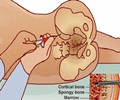New research has indicated that the electromagnetic rays from mobiles lead to decreased bone density in an area of the pelvis that is commonly used for bone grafts.
A study by Dr. Tolga Atay and colleagues of Suleyman Demirel University, Isparta, Turkey, found that with long-term exposure, electromagnetic fields from cell phones could weaken the bone, potentially affecting the outcomes of surgical procedures using bone grafts.The researchers measured bone density at the upper rims of the pelvis (iliac wings) in 150 men who were cell phone users and carried their phones on their belts.
They took the measurements via a technique called dual x-ray absorptiometry-the same test used to measure bone density in patients with osteoporosis and other bone diseases.
Bone density was compared on the side where the men wore their phones (the right side in 122 men and the left side in 28) versus the opposite side.
The men carried their phones for an average of 15 hours per day, and had used cell phones for an average of 6 years.
The results showed a slight reduction in iliac wing bone density on the side where the men carried their phones.
Advertisement
However, the researchers have noted that the men were relatively young-average 32 years-and that further bone weakening may occur with longer follow-up.
Advertisement
The ilac wings are a widely used source of bone for bone grafting, so any reduction in bone density may be of special importance to reconstructive surgery.
However, the researchers emphasize that their findings are preliminary.
Meanwhile, Atay and colleagues concluded: "It would be better to keep mobile phones as far as possible from our body during our daily lives."
The study has been published in the September issue of The Journal of Craniofacial Surgery.
Source-ANI
RAS









